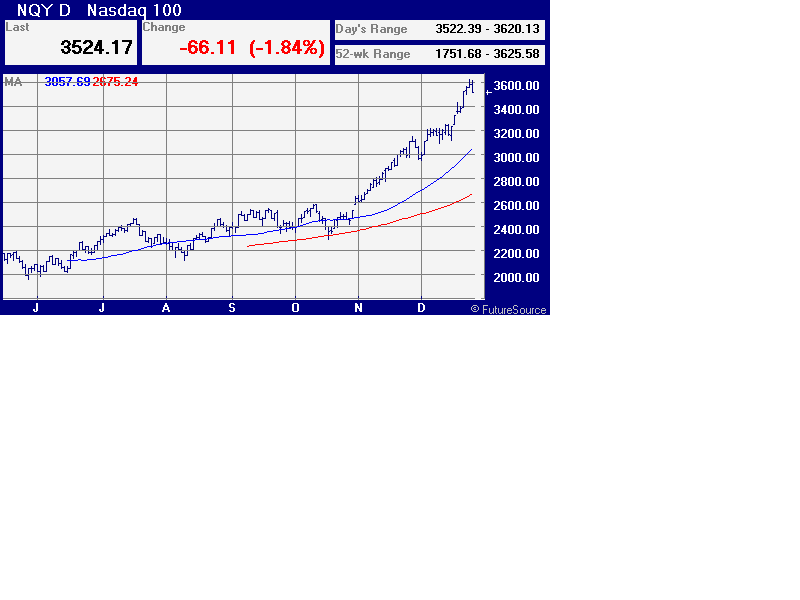
The Chart du Jour: A SPECIAL REPORT

December 26-27th. could be something of an important cycle period, and in the paragraphs below we will explain why.
Although he has been much defamed of late, Martin Armstrong of Princeton Economic Institute did no doubt stumble upon a unique cycle in financial market analysis. He began with the simple procedure of adding up all the financial panics between 1683 and 1907, and dividing the 224 intervening years by the number of panics that he found, 26 of them to be precise. The result was an average duration between panics of approximately 8.6 years. Of note, 8.6 years also equals 3141 days, or the mathmatical symbol of "pie" times 1000.
Armstrong went on to do a great deal of further research into this preliminary "cycle," noting that 6 individual 8.6 year cycles added together came to 51.6 years -- or something akin to the famous Kondratieff cycle. He also noted that many of the 8.6 year periods represented shifts in public sentiment away from government control of the economy, and then subsequently back toward it when a "bust" cycle became overwhelming. He noted that "politics seemed to ebb and flow in harmony with the business cycle."
Using the Crash of 1929 (1929.75) as his starting point, Armstrong was also amazed to find that his general 8.6 year rhythm worked in a remarkably prescient manner going forward in time -- often almost to the day. We list these cycle dates on the table below, each cycle lasting almost exactly 8.6 years, and have added our own Elliott Wave labeling for those so inclined.
Armstrong's work further divided his 8.6 year cycle into shorter, less significant cycle dates along the way of 4.3 years (a half-cycle), 2.15 years (a quarter cycle), and 8.6 months (or 1/6 of the total 51.6 months that comprise 8.6 years). These lesser cycle dates have seldom been as easy to read or anticipate, but they have often ushered in interesting shifts in global capital flows. For example, starting from the U.S. equity market high of 1972.75:
So it is that we note that 8.6 months after the July 20, 1998 equity high was April 8, 1999 (1-day shy of a significant high in the Internet DOT Index that led to over a 30% correction); and December 26-27th is now another 8.6 months later. September 13, 2000 will be the next 8.6 month cycle date and also the 2.15 year cycle date. Could an equity market high now lead to a significant low then? We certainly think that this is entirely possible, if not probable.
Consider the impact of the calendar. January 1, 2000 will not only mark the beginning of a new millenium, but more immediately, it will mark the beginning of a NEW TAX YEAR. For those sitting with large gains, it will offer a more natural time to cash out some of these gains rather than doing so right now. Why pay Uncle Sam in three-months time if you can pay him 15-months hence? A bevy of recent Internet IPO's will also see their insider "lockup" periods expire during the forthcoming few months. It should be a natural time to say "Thank you PaineWebber" and put money in the bank.
In addition, we still put some stock in the prognostications of economist Ed Yardeni. Although much maligned as an off-target Y2K alarmist, he continues to put a 70% probability on a Y2K induced recession of some sort. (Pay for our article "Crude Oil and Ed Yardeni: A Technical Perspective". In addition, our work outlined in the article "A 13th Century Mathematician and the Current Rhythm of the DJIA" point to a level reasonably close to current levels as a natural one to mark at least a temporary high.
So overall, Martin Armstrong may have been sloppy in his back-office controls, and perhaps even guilty of the charges that stand against him as a money manager (we will see what the courts decide), but in the study of the fractal nature that our calendar seems to naturally divide itself, we think that he was most definately a gifted visionary of some sort. Keep both December 26/27th and September 13, 2000 firmly in mind as you make investment decision into the new year. The midway point between those two dates (or 4.3 months from today), May 5, 2000 could easily mark a point of realization by the masses that stocks do not always "grow to the moon." In between now and then, a step and a stumble lower could easily transpire.
Thank you for visiting Sand Spring Advisors LLC, Inc. We hope to hear from you again soon. For more information on Sand Spring Advisors actual programs, services, or to request a copy of a Disclosure Document, please phone us at 973 451 0016, FAX your request to 973-451-0016, or e-mail us at
SandSpringAdv@AOL.com| Corporate Office: 10 Jenks Road, Morristown, NJ 07960 Phone: 973 451 0016 Facsimile: 973 451 0016 |
Best Experienced with
The material located on this website is also the copyrighted work of Sand Spring Advisors LLC. No party may copy, distribute or prepare derivative works based on this material in any manner without the expressed permission of Sand Spring Advisors LLC
This page and all contents are Copyright © 1999 by Sand Spring Advisors, LLC, Morristown, NJ